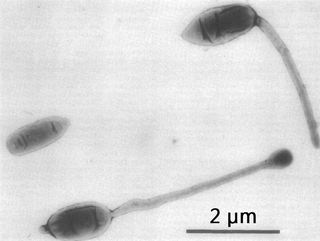
Halomonadaceae is a family of halophilic Pseudomonadota.

Nitrosomonas is a genus of Gram-negative bacteria, belonging to the Betaproteobacteria. It is one of the five genera of ammonia-oxidizing bacteria and, as an obligate chemolithoautotroph, uses ammonia as an energy source and carbon dioxide as a carbon source in presence of oxygen. Nitrosomonas are important in the global biogeochemical nitrogen cycle, since they increase the bioavailability of nitrogen to plants and in the denitrification, which is important for the release of nitrous oxide, a powerful greenhouse gas. This microbe is photophobic, and usually generate a biofilm matrix, or form clumps with other microbes, to avoid light. Nitrosomonas can be divided into six lineages: the first one includes the species Nitrosomonas europea, Nitrosomonas eutropha, Nitrosomonas halophila, and Nitrosomonas mobilis. The second lineage presents the species Nitrosomonas communis, N. sp. I and N. sp. II, meanwhile the third lineage includes only Nitrosomonas nitrosa. The fourth lineage includes the species Nitrosomonas ureae and Nitrosomonas oligotropha and the fifth and sixth lineages include the species Nitrosomonas marina, N. sp. III, Nitrosomonas estuarii and Nitrosomonas cryotolerans.
Alteromonas is a genus of Pseudomonadota found in sea water, either in the open ocean or in the coast. It is Gram-negative. Its cells are curved rods with a single polar flagellum.
The genus Methylophaga consists of halophilic methylotrophic members of the Gammaproteobacteria, all of which were isolated from marine or otherwise low water activity environments, such as the surface of marble or hypersaline lakes. The cells are rod-shaped. and are motile by a single polar flagellum.

Lactobacillus johnsonii is a species in the genus Lactobacillus identified in 1980 by John L. Johnson, an American microbiologist and his associates. Its type strain is ATCC 33200. It is part of the healthy vaginal microbiota and has been identified as having probiotic properties. The L. johnsonii strain La1 was one of the first cultures to be proposed as a probiotic dairy supplement in 1995 at the Nestlé Research Center, Lausanne. Although yeast and bacteria have been used in dairy products for fermenting purposes for centuries, the investigation and choice of a microorganism as a fermenting agent based on its health benefits was novel at the time. Today the probiotic culture is used in the LC1 yogurt products by Nestlé.
Leptospira alexanderi is a species of Leptospira. Its type strain is strain L 60T.
Brucella anthropi is a bacterium. The type strain is strain CIP 82.115. O. anthropi strains are rod-shaped, aerobic, gram-negative, non-pigmented and motile by means of peritrichous flagella. They are emerging as major opportunistic pathogens.
Psychrobacter cryohalolentis is a Gram-negative, nonmotile species of bacteria. It was first isolated from Siberian permafrost. Its type strain is K5T.
Psychrobacter arcticus is a Gram-negative, nonmotile species of bacteria first isolated from Siberian permafrost. Its type strain is 273-4T.
Helicobacter acinonychis is a bacterium in the Helicobacteraceae family, Campylobacterales order. It was first isolated from cheetahs with gastritis, so has been associated with this disease in this particular species and others of its kind. It is Gram-negative, spiral-shaped, and grows under microaerophilic conditions. The type strain is 90-119.
Deinococcus murrayi is a bacterium. It produces orange-pigmented colonies and has an optimum growth temperature of about 45 °C (113 °F) to 50 °C (122 °F). It is extremely gamma radiation-resistant. Its type strain is ALT-1b.
Vagococcus fluvialis is a species of bacteria. The type strain of V. fluvialis is NCDO 2497. It rarely causes human infection. The only genetically proven case of V. fluvialis endocarditis was detected in the Cochin, India.
Luteimonas marina is a bacterium. Its type strain is FR1330(T).
Hydrogenovibrio crunogenus is a colorless, sulfur-oxidizing bacterium first isolated from a deep-sea hydrothermal vent. It is an obligate chemolithoautotrophic sulfur oxidizer and differs from other species of this genus by its DNA base composition and by its growth rate and optimal pH in thiosulfate medium. ATCC 35932T is the type strain of the species. It was originally published in the genus Thiomicrospira as Thiomicrospira crunogena but was reclassified to the genus Hydrogenovibrio in 2017, resulting a grammatical gender change of the specific epithet from crunogena to crunogenus. The genome sequence of H. crunogenus XCL-2 has been published but that of the type strain has not yet been undertaken.
Citrobacter farmeri is a Gram-negative species of bacteria.
Citrobacter sedlakii is a species of Gram-negative bacteria. It has been described as causing human disease, but is generally found as a non-pathogenic organism in human stools.
Corynebacterium otitidis is a coryneform Gram-positive bacterium first isolated from patients with otitis media.
Methylophaga thalassica is an obligately methylotrophic, Gram-negative, strictly aerobic, motile, rod-shaped bacteria. Its type strain is ATCC 33146.

Hyphomicrobium is a genus of Gram-negative, non-spore-forming, rod-shaped bacteria from the family of Hyphomicrobiaceae. It has a large polar or sub-polar filiform prostheca very similar to that of Caulobacter. In addition to having a nutritional function, the prostheca also plays a role in the initiation of DNA replication.
Methylophaga muralis is a species of Pseudomonadota. It is capable of surviving in saline and alkaline environments and can obtain its carbon from methanol. This species was originally discovered in crumbling marble in the Moscow Kremlin; it has also been found in a soda lake in Buryatia.



